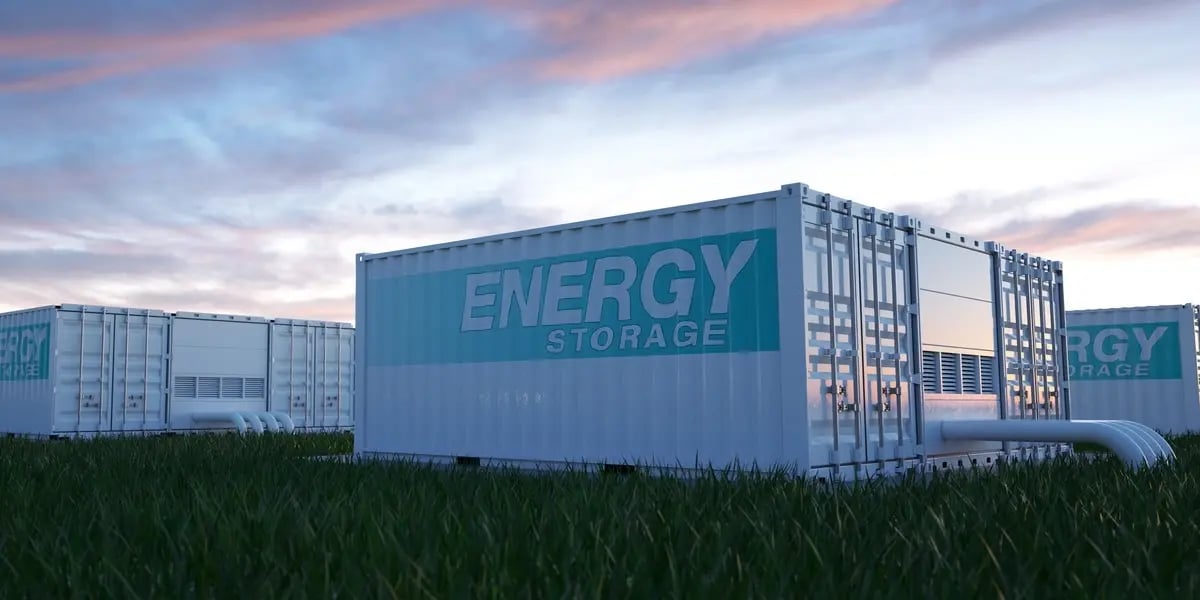Battery Storage Costs
Free Permitting Checklist
Practical Tips to Avoid Environmental Risk on all Your Projects
Download our environmental permitting checklist to get a step-by-step list of ways to protect your project from the 9 most common environmental risks.
Download Your Checklist
Project finance remains one of the most crucial parts of the clean energy development process. As new technologies to support our microgrid are introduced, energy storage via lithium-ion batteries and other energy storage systems will continue to be perfected. As these systems are developed, the best option for energy storage financing will be top of mind for land developers.
What Are Battery Energy Storage Systems (BESS)?
Battery energy storage systems (BESS) provide an advanced technological solution that allows renewable forms of energy to be stored and distributed when consumers need power. A BESS is typically used in electricity grids, electric vehicles, solar power installations and smart homes, relying on one or more batteries with stored electrical energy. The interconnection between the energy source and the battery type defines a BESS.
Energy resources such as hydro or wind power are not constantly in production. In the case of a solar project, its energy production is subject to the hours of sunshine and cloud and tree cover. Therefore, when this energy is not stored, a significant number of megawatt hours (MWh) of power are lost annually. Battery energy storage systems created the bankability for this energy to be accessed later. Even when the sun isn't shining and the air is still as it can be, these batteries can be charged using excess electricity generated by wind or solar power, thus storing electricity until it is released. This ability to charge a battery during times of low demand for access to energy during high demand is often referred to as energy arbitrage
Power Purchase Agreements (PPAs)
What Are PPAs?
A power purchase agreement, or PPA, refers to a long-term contract where a developer arranges, owns and operates a renewable energy system on a customer's (or other entities’) property. The developer then sells the power generated to the customer at a fixed rate, providing a means to receive reliable and often low-cost electricity. PPAs span 10 to 20+ years, defining commercial requirements and terms for the sale of renewable electricity like the start and end date, delivery schedule, payment terms and termination conditions. PPAs with 10+ year terms are becoming customary in California. At the end of a PPA term, the customer can reevaluate the system by either buying out the owner, renewing the contract or ending the agreement altogether, resulting in the removal of the system. With little to no up-front costs, PPAs provide an accessible.
Who Uses PPAs?
Utility-scale projects (utility) and large-scale projects (government or company) utilize PPAs to lock in a fixed price for electricity over the long term to diverge the risk of volatile power markets while honing in on energy savings and sustainability. With any PPA, the capital comes from the investor, allowing host customers the opportunity to finance an energy project with a contractual agreement. Paying a fixed rate for the terms of the contract, projects of a utility-scale upwards of 1 megawatt generally use PPAs. There are 15 states in the U.S. with active legislation that authorizes and/or regulates PPAs, including Arkansas, Colorado, Connecticut, Delaware, Hawaii, Iowa, Michigan, Montana, Nebraska, New Hampshire, New Jersey, Oregon, Rhode Island, Virginia and Washington.
Risks of PPAs
There are a handful of risks and challenges involved with a PPA, including the following:
-
PPAs are generally long-term, 10- to 20-year agreements.
-
Fixed rates mean customers risk paying more for electricity if prices decline.
-
Operational risks are involved, such as mechanical failures.
-
Host customers do not have the same financial benefit as a third-party developer. The customer is not eligible for state or federal subsidies like tax credits or SMART payments because the third-party developer owns the system.
-
Available primarily to host customers in competitive electricity markets.
- To ensure green power claims, customers need renewable energy certificate (REC) ownership.
%20(2).webp?width=1111&height=556&name=AdobeStock_248626760%20(3)%20(2).webp)
Offtake Agreements
Similar to, a PPA, an offtake agreement is structured for a buyer to purchase all or some of a product- in this case energy. These are long-term contracts in which they buy or a connected third party may sell the energy.
Risks to Offtake Agreements
The resiliency of the system itself is the hurdle of the offtake agreement. Should the system fail, underproduce, or delay production- it can impact the buyer, consumer, and producer alike.
Ancillary Services
Ancillary services support the transmission of electricity by maintaining its usability. These systems support energy storage by maintaining the flow of electricity, intervening with solutions in system imbalances, and helping restore the system if a power system disturbance or contingencies occur (i.e., outages and changes in supply and demand). Ancillary services may include:
-
Synchronized/frequency regulation
-
Spinning reserves
-
Contingency reserves
-
Replacement reserves
-
Voltage support
-
Black-start regulation
-
Flexibility reserves
How Do These Support Development?
According to the International Renewable Energy Agency, electricity systems require various ancillary services to operate smoothly. Ancillary services support electrical power systems by improving and enhancing reliability in these complex systems.
Energy storage stacked with ancillary services like spinning reserves and voltage support presents an opportunity for industry developers to build more revenue streams, also known as "value-stacking."
Risk of Ancillary Services
Ancillary services allow for flexible capacity, thus maintaining a secure operation to keep up with supply and demand. Functioning like a two-sided scale, ancillary services maintain a reliable power supply. So if a power grid fails (i.e., a blackout), these services help restart the grid. However, more volatile grids require ancillary services that just any generation source can’t always generate.
Storage Capacity and Financing
The cost and terms of bank financing for energy storage projects depend on physical location and what segment of the storage market the project is in regionally. The case for financing varies by state. For example, the investment case for a project in PJM is much different than Texas' ERCOT (or California) because of price volatility in the PJM market failing to achieve what already exists in California or ERCOT. This is the case due to how geographically diverse the latter markets are.
There is a highly anticipated potential for growth where BESS’s storage capacity is concerned. Experts anticipate utility-scale battery storage to increase over the next three years, hitting 30.3 gigawatts (G.W.) by the end of the fourth quarter of 2025. On a broader scale, increased capacity for BES projects is taking hold as more battery capacity becomes available to the U.S. grid. Today, capacity operates under 10GW, on par with 2021, but anticipated to increase by the end of the year.
Free Permitting Checklist
Practical Tips to Avoid Environmental Risk on all Your Projects
Download our environmental permitting checklist to get a step-by-step list of ways to protect your project from the 9 most common environmental risks.
Tax Credit Incentives
The Inflation Reduction Act
The Inflation Reduction Act, or IRA, was signed into law by President Biden on Aug. 16, 2022, enacting the most significant federal investment towards combating climate change in United States history with a $369 billion budget out of the total $430 billion package. As a U.S. energy storage deployment, the IRA will work to decrease greenhouse gas emissions by accelerating the deployment of low carbon technologies and spur domestic manufacturing."
Now with the IRA, standalone energy storage assets are eligible for investment tax credit (ITC). ITC went up to 30% for standalone storage and solar-plus-storage facilities with a 10-year fixed term. Before the enactment of this legislation, "energy storage projects were only eligible for the ITC if the batteries were paired directly to a solar energy project." Now, energy storage projects with a minimum capacity of 5kWh are eligible. These incentives for energy storage projects went into effect on Jan. 2, 2023.
Statewide Incentives
State mandates and financial incentives for energy storage systems in states like California help spur development and combat climate change. The California Public Utilities Commission, a quasi-executive state government agency that regulates investor-owned electrical and natural gas utilities in California, launched the Self-Generation Incentive Program (SGIP) in 2019. The SGIP offers rebates for qualifying distributed energy systems like wind turbines, waste heat-to-power technologies, pressure reduction turbines, and advanced energy storage systems, to name a few.
Texas, for example, does not offer a rebate program or tax incentive for distributed energy systems like California.
Demand Response Programs in New York state incentivize large energy users by offering revenue from their utility or the NYISO to those who use energy storage to lower their energy bill while reducing electricity usage simultaneously.
Forecasting for the Energy Sector
The energy storage market is projected to be a trillion-dollar market, with standalone battery storage projects anticipated to increase "fivefold over the next four years. According to P.A. Consulting energy market expert Mark Repsher, it is easily the fastest-growing segment of the renewable energy sector.
While bank financing is widely available for storage projects to date (with financing in California setting the stage for being the most attractive for developers looking at the feasibility of financing), the cost will continue to increase. You lock in your financing, and other projects must cost as early as possible to avoid racing the clock of affordability in a rapidly growing market.
Though the market is expected to grow, each financing options come with its own risks. Each project will favor a different financing structure as the needs of a startup operation versus a large, established, utility-scale company will differ.

Lenders' Hesitation to Fund Energy Storage Technologies
Lenders face a challenge transitioning from contracted revenue structures to merchant risk projects. One of the biggest challenges today is divergent regional markets and the need for standardized technologies. Let's look at California and Texas' ERCOT as an example: two of the biggest U.S. markets for energy storage, but with different technological requirements and overall market structures.
Limit the Cost of Energy Storage Projects
Early Stage Environmental Due Diligence
Environmental due diligence is the process of evaluating environmental conditions and risks associated with a property. This process is traditionally done by an environmental consultant, an expert in biology and trained in America’s rules and regulations for land developers. These consultants produce a Critical Issues Analysis (CIA), outlining all of the protected environmental features on a site. The track record for the timeline for these documents is a few weeks to months at an average of $5,000 per report.
In any project, it's important to measure risk early on to ensure your project development is the most lucrative in the long term. Automation tools in the marketplace, like Transect's environmental due diligence software platforms, generate on-demand, site-specific reports in 90 seconds. The reports show all environmental risks present on and required permits for a site. The report contains all the information found in a typical CIA report as well as next steps and access to timely expert reviews. The report can be shared with the whole team; from the project’s managing director to the investor, everyone can be in the know.
The software allows land developers to see project risks before the procurement of a site to ensure an action and mitigation plan is established early on or a more suitable site is selected. The optimization of this process speeds up the timeline between beginning a project and seeing a return on it via power generation. The annual subscription allows multiple reports to be run at once and site comparison, rather than the traditional pay-per-report model. As project sites don’t come with a warranty, these few minutes of search help avoid costly delays and poor site selection.
Free Permitting Checklist
Practical Tips to Avoid Environmental Risk on all Your Projects
Download our environmental permitting checklist to get a step-by-step list of ways to protect your project from the 9 most common environmental risks.
